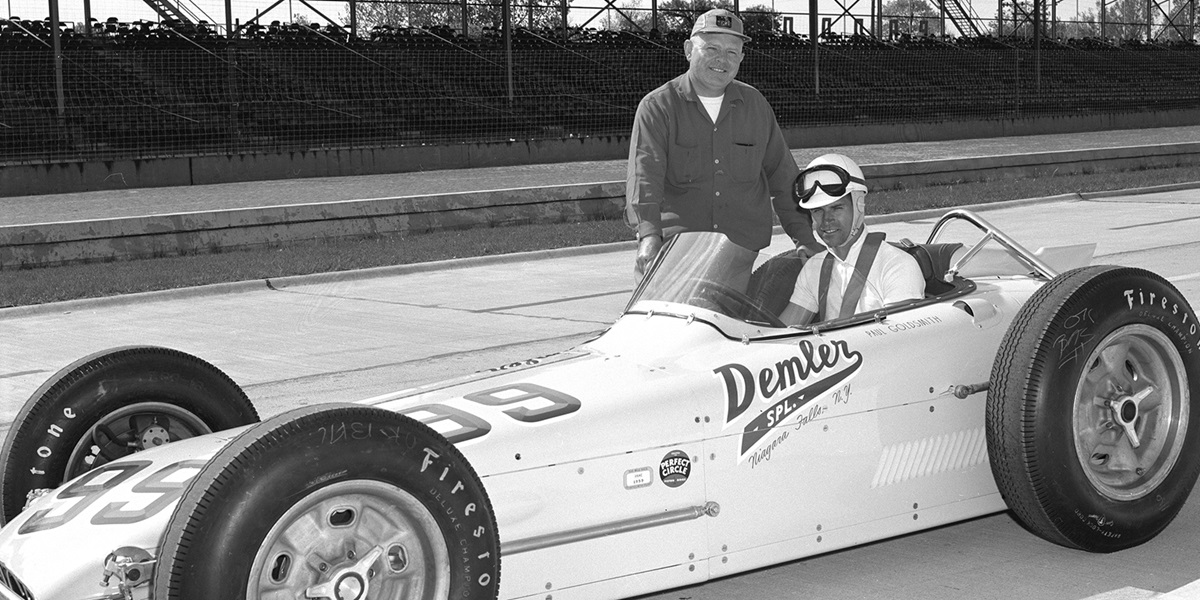
Goldsmith Was Constant Contender for Victory on Two or Four Wheels
July 07, 2020 | By Donald Davidson
When reference is made to Paul Goldsmith winning an event at Milwaukee, Langhorne or over the sands of Daytona Beach, one has to specify whether the type of motorsport being discussed involves four wheels or two. Typically, a person will be inducted into the Hall of Fame because of his or her accomplishments in one discipline or the other. In the case of the extremely stoic Goldsmith―a man of very few words―it could be either.
Born in Parkersburg, West Virginia, the Michigan-raised Goldsmith began racing motorcycles as a teenager right after the conclusion of World War II. He jumped immediately to the rank of AMA "expert" on Harley-Davidson equipment and raced for the next several years while continuing to hold down a full-time factory job at Chrysler. His first major win, in 1952, came most fortuitously on the 1-mile dirt track at the Wisconsin State Fairgrounds (later the famed Milwaukee Mile), not far from the Harley-Davidson headquarters.
In 1953, he won both the Daytona 200 on the old beach road course (his Harley prepared partially by the legendary Smokey Yunick), and the grueling 100-miler at the treacherous Langhorne, Pennsylvania, dirt track.
From its very beginnings, AMA had typically declared a variety of seasonal champions based on single events, even its national championship being awarded to the winner of the Springfield, Illinois, race. Finally, in 1954, it was decided to award points to the first few finishers in a series of races, and it was Goldsmith who ended up second in the standings, beaten only by a West Coast rider he had befriended and taken under his wing several years earlier, Joe Leonard.
In the meantime, Goldsmith had begun to dabble in stock car racing, winning a 250-miler at the Detroit Fairgrounds in 1953. Later teaming with Yunick, he won his first NASCAR race (a 300-miler at Langhorne) in 1956, and in February 1958, with construction of the Daytona International Speedway already underway, he won the final NASCAR Grand National classic over the beach course.
In May 1958, he achieved a lifelong ambition by driving in the Indianapolis 500, although his race lasted only three-quarters of a lap. Driving a Yunick-entered Offenhauser-powered Kurtis–Kraft, he was caught up in the multi-car accident which took the life of Pat O'Connor. Goldsmith drove in five more 500s after that, placing fifth in 1959 and third in 1960. In fact, his race laps were only a fraction of the number he turned at IMS during his career, as he succeeded Rodger Ward and O'Connor as Firestone's chief test driver.
Teamed up since 1959 with Ray Nichels, Goldsmith dominated the USAC stock car circuit with Nichels Engineering Pontiacs, finishing second in points in 1960, winning in 1961 and 1962, and, after a dispute with USAC, finishing second again, this time with a Plymouth, in 1965. During his pair of championship-winning seasons he won almost half of the races, with 18 wins in 39 starts.
Goldsmith was back and forth with NASCAR for several seasons and normally ran only selected races. In 1966, however, he finished fifth in points, with three wins and three seconds. In 1969, he retired to devote full time to his varied business ventures, which included ownership of an airport in northern Indiana, an aviation engine repair business, some fast food restaurants and a pair of thoroughbred horse ranches. He also trained commercial airline pilots and worked with Purdue University on the development of a fuel-saving hydraulic intensifier.